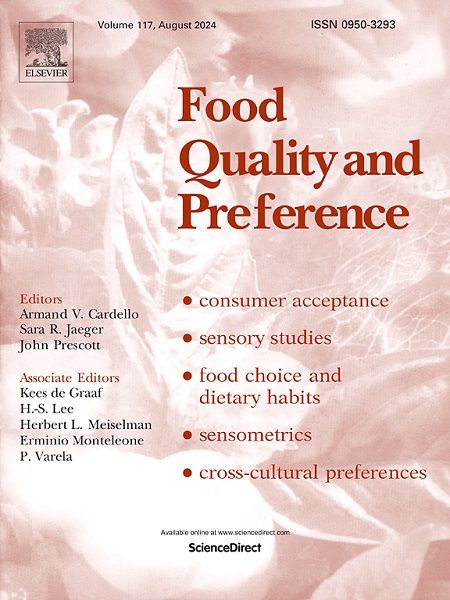Exploring the preferences of French university students using real-life food sourcing data: A proof-of-concept study
IF 4.9
1区 农林科学
Q1 FOOD SCIENCE & TECHNOLOGY
引用次数: 0
Abstract
Taste and preferences play a crucial role in shaping eating behaviours. However, research on the factors influencing university students' preferences in real-life settings and at the diet level remains limited. This article presents the results of a study conducted with a sample of French students who collected data on the food they personally sourced during one month alongside hedonic scores. Food preferences were compared based on food categories, sourcing locations, consumption frequencies, and the nutritional, environmental, economic, and sensory properties of the foods. The results showed that about 75 % of the sourced foods were highly appreciated, and preferred foods were generally but not systematically consumed more frequently. However, students' diet also included 25 % of moderately liked foods, such as utilitarian and routine foods. Students' preferences often conflicted with higher nutritional quality but not with lower environmental impact. Among the factors influencing preferences, foods with sweet and fatty tastes and ready-to-eat foods were generally preferred, while foods requiring culinary preparation and lower-priced foods within a category were less liked. The context in which food was sourced proved to be the most influential factor, with foods served in collective catering settings being the least liked. Certain food categories, such as fruits, emerged as offering both sensory enjoyment and potential health and sustainability benefits. This research underscores the relationships between food choices, sensory perceptions, preferences, and the context in which foods are sourced and consumed. From a methodological standpoint, it highlights the potential of real-life data collection in better understanding food consumption behaviours in relation to preferences and emphasizes the need to continue developing large-scale, ecological approaches that integrate sensory experiences within a broader context.
利用现实生活中的食物采购数据探索法国大学生的偏好:一项概念验证研究
口味和偏好在塑造饮食行为中起着至关重要的作用。然而,在现实生活环境和饮食水平上对大学生偏好的影响因素的研究仍然有限。这篇文章展示了一项研究的结果,该研究以法国学生为样本,收集了他们在一个月内亲自采购的食物和享乐得分的数据。根据食物类别、采购地点、消费频率以及食物的营养、环境、经济和感官特性来比较食物偏好。结果显示,约75%的来源食物是高度赞赏的,并且喜欢的食物一般但不是系统地更频繁地消费。然而,学生的饮食也包括25%的中等喜欢的食物,如实用和日常食物。学生的偏好往往与较高的营养质量相冲突,但与较低的环境影响并不冲突。在影响偏好的因素中,甜味和脂肪味的食物和即食食品普遍受到青睐,而需要烹饪的食物和某一类中价格较低的食物则不太受欢迎。食物来源的环境被证明是最具影响力的因素,在集体餐饮环境中提供的食物最不受欢迎。某些种类的食物,如水果,既能提供感官享受,又能带来潜在的健康和可持续效益。这项研究强调了食物选择、感官知觉、偏好和食物来源和消费环境之间的关系。从方法论的角度来看,它强调了现实生活数据收集在更好地理解与偏好相关的食物消费行为方面的潜力,并强调需要继续开发大规模的生态方法,在更广泛的背景下整合感官体验。
本文章由计算机程序翻译,如有差异,请以英文原文为准。
求助全文
约1分钟内获得全文
求助全文
来源期刊

Food Quality and Preference
工程技术-食品科技
CiteScore
10.40
自引率
15.10%
发文量
263
审稿时长
38 days
期刊介绍:
Food Quality and Preference is a journal devoted to sensory, consumer and behavioural research in food and non-food products. It publishes original research, critical reviews, and short communications in sensory and consumer science, and sensometrics. In addition, the journal publishes special invited issues on important timely topics and from relevant conferences. These are aimed at bridging the gap between research and application, bringing together authors and readers in consumer and market research, sensory science, sensometrics and sensory evaluation, nutrition and food choice, as well as food research, product development and sensory quality assurance. Submissions to Food Quality and Preference are limited to papers that include some form of human measurement; papers that are limited to physical/chemical measures or the routine application of sensory, consumer or econometric analysis will not be considered unless they specifically make a novel scientific contribution in line with the journal''s coverage as outlined below.
 求助内容:
求助内容: 应助结果提醒方式:
应助结果提醒方式:


